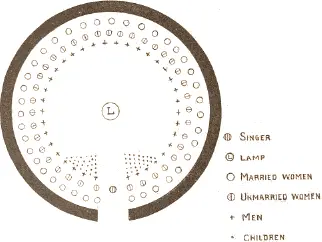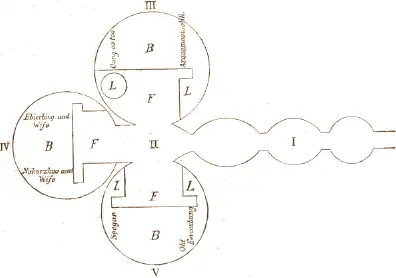Before long a woman entered carrying an oblong vessel in which her ulo (see p. 518) lay. She put it on the floor and stooped forward, turning the vessel like a whirligig. Then she commenced dancing, and when she turned her back toward the angakoq it was made manifest that she was hollow. She had no back, backbone, or entrails, but only lungs and heart.
The man joined her dance and their attitudes and grimaces looked so funny that the angakoq could scarcely keep from laughing. But just at the right moment he called to mind the warnings of the man in the moon and rushed out of the house. The man cried after him, “Uqsureliktaleqdjuin” (“Provide yourself with your large white bear tornaq”). 7Thus he escaped unhurt.
Upon another visit he succeeded in mastering his inclination to laugh and was hospitably received by the man after the performance was finished. He showed him all around the house and let him look into a small additional building near the entrance. There he saw large herds of deer apparently roaming over vast plains, and the man of the moon allowed him to choose one animal, which fell immediately through a hole upon the earth. In another building he saw a profusion of seals swimming in an ocean and was allowed to pick out one of these also. At last the man in the moon sent him away, when his tornaq carried him back to his hut as quickly as he had left it.
During his visit to the moon his body had lain motionless and soulless, but now it revived. The thongs with which his hands had been fastened had fallen down, though they had been tied in firm knots. The angakoq felt almost exhausted, and when the lamps were relighted he related to the eagerly listening men his adventures during his flight to the moon.
It is related in the course of this tradition that the man in the moon has a qaumat, some kind of light or fire, but I could not reach a satisfactory understanding of the meaning of this word. It is derived from qauq (daylight) and is used in Greenland for the moon herself. Among the Eskimo of Baffin Land it is only employed in the angakoq language, in which the moon is called qaumavun, the sun qaumativun. Another name of the moon is aninga (her brother), in reference to the first legend. The natives also believe that the man in the moon makes the snow. He is generally considered a protector of orphans and of the poor, and sometimes descends from his house on a sledge drawn by his dog, Tirie´tiang, in order to help them (see the tradition of Qaudjaqdjuq, p. 630).
Table of Contents
It is said that three sisters make the lightning, the thunder, and the rain. The names of two of them are Ingnirtung (the one who strikes the fire) and Udluqtung (the one who rubs the skins), whose second name is Kadlu (thunder), while that of the third I could not ascertain. They live in a large house the walls of which are supported by whale ribs. It stands in the far west, at a great distance from the sea, as Kadlu and her sisters do not like to go near it. If an Eskimo should happen to enter the house he must hasten away or Ingnirtung will immediately kill him with her lightning. Even the stones are afraid of her and jump down the hills whenever they see the lightning and hear the thunder. The faces of the sisters are entirely black and they wear no clothes at all.(?) Ingnirtung makes the lightning by striking two red stones together (flint). Kadlu makes the thunder by rubbing sealskins and singing. The third sister makes the rain by urinating. They procure food by striking reindeer with the lightning, which singes their skins and roasts their flesh. The Akudnirmiut say that beyond Iglulik, on the continent of America, a large tribe of Eskimo live whom they call Kakī´joq. The women of the tribe are said to have rings tattooed round their eyes. These natives offer the dried skins of a species of small seals to Kadlu, who uses them for making the thunder.
Feasts, Religious and Secular
Table of Contents
The Eskimo have some very interesting feasts, most of which are closely connected with their religious notions. In summer feasts are celebrated in the open air, but in winter a house, called qaggi, or, as we may call it, singing house, is built for that purpose.

Fig. 531. Diagram showing interior of qaggi or singing house among eastern tribes.
The plan of the house which is used by the eastern tribes is represented in Fig. 531. It is a large snow dome about fifteen feet in height and twenty feet in diameter, without any lining. In the center there is a snow pillar five feet high, on which the lamps stand. When the inhabitants of a village assemble in this building for singing and dancing the married women stand in a row next the wall. The unmarried women form a circle inside the former, while the men sit in the innermost row. The children stand in two groups, one at each side of the door. When the feast begins, a man takes up the drum (kilaut), which will be described presently, steps into the open space next the door, and begins singing and dancing. Among the stone foundations of Niutang, in Kingnait (Cumberland Sound), there is a qaggi built on the same plan as the snow structure. Probably it was covered with a snow roof when in use.

Fig. 532. Plan of Hudson Bay qaggi or singing house. (From Hall II, p. 220.)
Hall gives the plan of the Hudson Bay qaggi (Fig. 532), a copy of which is here introduced, as well as his description of the drum (Fig. 533), which I have never seen made (Hall II, p. 96):

Fig. 533. Kilaut or drum.
The drum is made from the skin of the deer [or seal], which is stretched over a hoop made of wood, or of bone from the fin of a whale, by the use of a strong, braided cord of sinew passed around a groove on the outside. The hoop is about 2½ inches wide, 1½ inches thick, and 3 feet in diameter, the whole instrument weighing about 4 pounds. The wooden drumstick, 10 inches in length and 3 inches in diameter, is called a kentun. ***
The deerskin which is to be the head of the instrument is kept frozen when not in use. It is then thoroughly saturated with water, drawn over the hoop, and temporarily fastened in its place by a piece of sinew. A line of heavy, twisted sinew, about 50 feet long, is now wound tightly on the groove on the outside of the hoop, binding down the skin. This cord is fastened to the handle of the kilaut [drum], which is made to turn by the force of several men (while its other end is held firmly), and the line eased out as required. To do this a man sits on the bed-platform, “having one or two turns of the line about his body, which is encased in furred deerskins, and empaled by four upright pieces of wood.” Tension is secured by using a round stick of wood as a lever on the edge of the skin, drawing it from beneath the cord. When any whirring sound is heard, little whisps of reindeer hair are tucked in between the skin and the hoop, until the head is as tight as a drum.
performer, who strikes the edge of the rim opposite that over which the skin is stretched. He holds the drum in different positions, but keeps it in a constant fan-like motion by his hand and by the blows of the kentun struck alternately on the opposite sides of the edge. Skillfully keeping the drum vibrating on the handle, he accompanies this with grotesque motions of the body, and at intervals with a song, while the women keep up their own Inuit songs, one after another, through the whole performance.
Читать дальше















